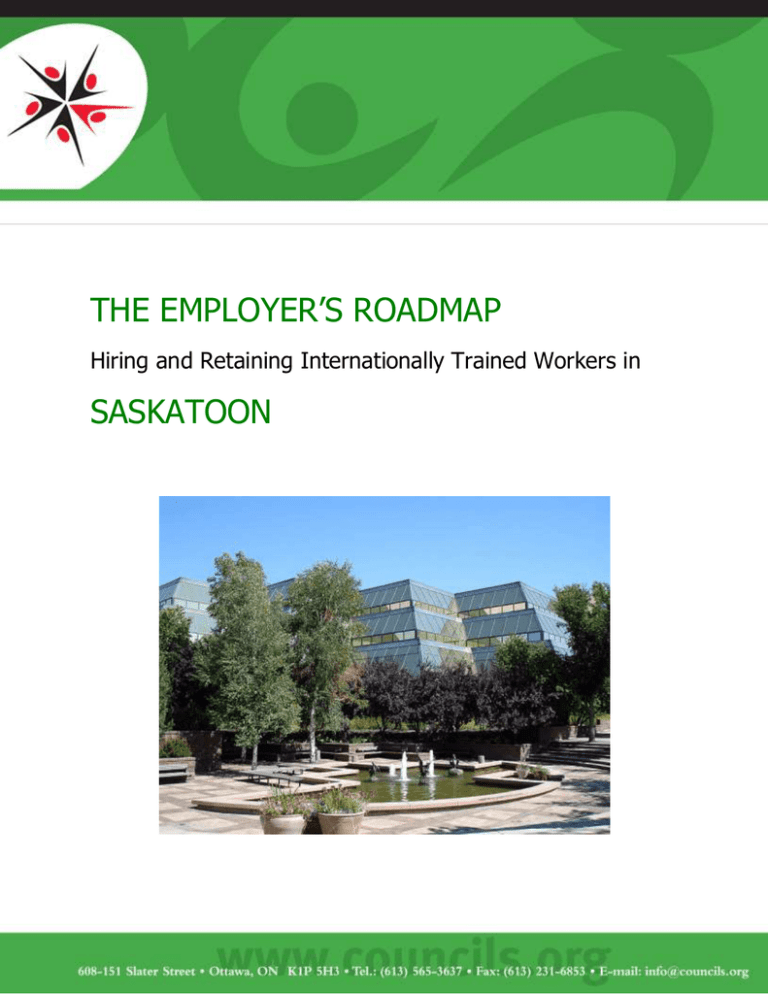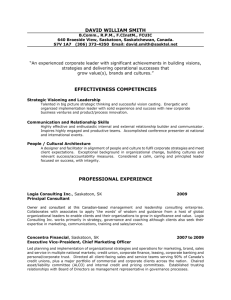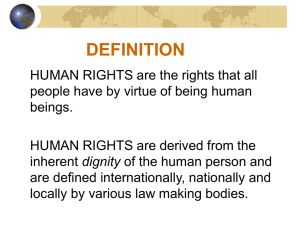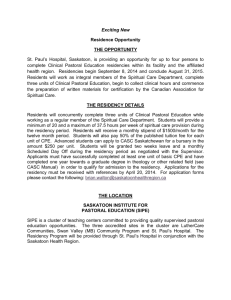Hiring and Retaining Internationally Trained Workers in Saskatoon
advertisement

THE EMPLOYER’S ROADMAP Hiring and Retaining Internationally Trained Workers in SASKATOON This publication is one in a series of Regional Employer Roadmaps produced by The Alliance of Sector Councils (TASC). In 2009, TASC developed The Employer’s Roadmap to Hiring and Retaining Internationally Trained Workers for the Foreign Credentials Recognition Office (FCRO) of Citizen and Immigration Canada (CIC). This roadmap is a practical guide for employers in small- to medium-sized enterprises (SMEs) and provides information about practices, policies and programs at a national level. The Regional Employer Roadmaps build upon this national guide by providing information and resources specific to different regions of Canada. TASC thanks all employers and other stakeholders who provided input into the development of this document. This project is made possible through funding from the Government of Canada (Citizenship and Immigration Canada). Project Coordinator: Constance Lim, LIM Consulting Associates Writer: Dennis Chubb, Vadis Consulting Cover photo: Galleria Building, Innovation Place Saskatoon from Wikipedia (author: Drm301) © The Alliance of Sector Councils 2012 For more information, contact: The Alliance of Sector Councils 608-151 Slater Street Ottawa, ON K1P 5H3 Tel: (613) 563-3637 Fax: (613) 231-6853 www.councils.org La version en français est disponible sur demande. Table of Contents 1 What is the Roadmap?........................................................................................4 2 Why Hire Internationally Trained Workers? ..........................................................5 3 Understanding Your Needs..................................................................................6 4 3.1 The Job.......................................................................................................6 3.2 Language ....................................................................................................6 3.3 Credentials, Knowledge, Skills and Abilities ....................................................7 3.4 The Time Factor ..........................................................................................7 3.5 Cost Considerations .....................................................................................8 Finding Internationally Trained Workers ...............................................................9 4.1 Local Channels .......................................................................................... 10 4.2 Overseas Channels .................................................................................... 11 5 Integrating and Retaining Internationally Trained Workers .................................. 13 6 Resources ........................................................................................................ 15 7 6.1 Community-Based Organizations ................................................................ 15 6.2 Other Resources ........................................................................................ 16 Useful TASC Resources ..................................................................................... 17 1 WHAT IS THE ROADMAP? This roadmap is intended to be a guide to help small- and medium-sized businesses navigate the processes, programs and information associated with employing internationally trained workers. It was designed to meet the needs of business owners and HR staff who need affordable and timely human-resource solutions for operating in a rapidly changing environment. Based on input from a diverse set of small- to mediumsized businesses and stakeholders in the Saskatoon area, we present tools, resources, supports and information to help you tap in to the talent pool of internationally trained workers. We hope this roadmap will help you understand and meet your hiring objectives. In February 2011, Statistics Canada released the latest population estimates, which show that Saskatoon replaced Alberta’s major cities to be the fastest-growing metropolitan area in Canada for the first time in decades. The population of Saskatoon has now exceeded 265,000 people, which means a three percent increase in comparison with the previous year, and a jump of more than 30,000 people since 2005. Vancouver and Regina rank the second and the third for fastest growth. According to Statistics Canada, the sharp increase in international immigration is the main factor that results in significant growth of Saskatoon. Saskatoon did see a flow of more than 3,300 new immigrants during the year, even higher than major Canadian cities such as Hamilton and Quebec City. This is due to the province’s expedited application program. The Saskatoon region is now the youngest of the metropolitan areas in the country, with the average age of 35.6 years. As well as high birth rates among the aboriginal population, the immigration of young families from overseas countries is seen as the key reason for that record. Saskatoon Regional Economic Development Authority at: http://sreda.com/ The Employer’s Roadmap Hiring and Retaining Internationally Trained Workers in Saskatoon 4 2 WHY HIRE INTERNATIONALLY TRAINED WORKERS? Hiring internationally trained workers is an important strategic business decision for employers in our region. The Saskatoon and Saskatchewan labour market faces a shortage of skilled and professional workers that is forecast to continue for a number of years. Saskatchewan’s economic growth will only be sustained if businesses can access the human resources needed to keep pace with opportunities in the local, national and international markets. Internationally trained workers have a number of skills that can help your business, such as: International skills, knowledge and experience; Speaking other languages; Helping your organization understand and support diversity; Enabling your organization to better reach and serve the new Canadians in our community; Bringing their dedication, loyalty and commitment to succeed; Allowing your organization to understand and build new networks; Adding new ideas, approaches and creative problem-solving based on experiences elsewhere; Assisting you in future employee recruitment efforts; Helping your organization become more effective in reaching global markets. Many local employers have hired internationally trained workers and they have consistently reported that these workers are motivated, skilled, productive and loyal employees who have made significant contributions beyond expectations. For example, Saskatoon health services and the community have benefited immensely from successfully recruiting nurses from the Philippines. Many local manufacturing businesses have met their growth targets because of their successful integration of welders and assembly line staff from other countries. Other employers have also had great success in hiring internationally trained workers already residing in Canada. Saskatchewan’s relative prosperity makes it an attractive destination in an increasingly competitive global market for top talent and skills. The Employer’s Roadmap Hiring and Retaining Internationally Trained Workers in Saskatoon 5 3 UNDERSTANDING YOUR NEEDS This section outlines a number of key points for you to consider before making the decision to recruit internationally trained workers. 3.1 THE JOB Be clear about the exact nature of the job that you are trying to fill. Make sure you specify details in the job description. For example, parts man is not the same as an agricultural parts man, and the tasks required for both jobs are quite different. Think about the hard (technical) and soft (people) skills required to perform the job. For example, will the employee be required to work as part of a team or to represent your company to English-speaking customers? Your industry association or sector council or the national occupational classifications may be able to provide assistance in defining and describing the tasks in certain occupations. Determine and outline whether you are recruiting to fill short-term needs or for more permanent, longer-term growth. 3.2 LANGUAGE Be clear about the minimum language requirements for the job. The requirements for the job will determine what level of language skills you will need in a suitable employee. Language requirements are often an important component for occupational health and workplace safety. Language proficiency required to perform many occupations has been already assessed and benchmarked using the Canadian Language Benchmarks (CLB). This is a practical, fair and reliable national standard for second language proficiency with a wide applicability in educational, training, community and workplace settings. The Centre for Canadian Language Benchmarks provides a downloadable series of Can Do Checklists for each level of language competency. These checklists can be used for needs assessment, goal setting, or self-assessment in relation to language learning. There are also a number of Language Assessment Centres in Saskatchewan that can assess the language proficiency of your candidates once you’ve determined what level you require. The Employer’s Roadmap Hiring and Retaining Internationally Trained Workers in Saskatoon 6 3.3 CREDENTIALS, KNOWLEDGE, SKILLS AND ABILITIES Consider whether your job requires employees that have formal credentials (diplomas, degrees, certificates, exams). 20% of all occupations in Canada are regulated which means that they have specific regulatory bodies that oversee the entry and right to practice for those occupations. Those regulatory bodies (for occupations such as doctors, engineers, architects) would assess the international credentials to determine whether the candidate is eligible to practice in Canada. If the position is non-regulated, employers still need to understand how a candidate’s international education and experience compares to Canadian standards. Be sure that you are clear on the actual skills and competencies required to perform the work so that you can tell prospective candidates and compare their skills. Decide whether you need to have their qualifications assessed by a specialized organization or whether you prefer to test them directly for a demonstration of their competencies. The Government of Saskatchewan has an inter-provincial agreement with the Government of Alberta to assess international credentials for Saskatchewan residents. This is done through the International Qualifications Assessment Service (IQAS) which provides a valuable service to immigrants and refugees seeking an assessment of the level of their educational qualifications in comparison to Saskatchewan standards. Contact IQAS at: 1-800-999-3965 (toll-Free from Saskatchewan) or visit the IQAS website. 3.4 THE TIME FACTOR It is crucial that you understand your staffing urgency so you can consider how much time you are able to commit to the recruitment process. Recruiting applications from internationally trained workers who already live in our region will not add additional time to your hiring process but will certainly broaden your talent pool. If you need to hire internationally trained workers from overseas through the Provincial Nominee Program or the various federal immigration programs the recruitment process will take longer. Hiring from overseas can take six months or more so it may not be the best solution for all employers. When an employer sponsors an internationally trained individual, the process for the immigrant goes much more quickly than the standard immigration process, but there are still the additional processes and paperwork for the employer that must be factored into your hiring timelines. The Employer’s Roadmap Hiring and Retaining Internationally Trained Workers in Saskatoon 7 3.5 COST CONSIDERATIONS It may be worth your while to engage a human resource consultant who has experience in recruitment and workforce development. Though they charge fees, a knowledgeable and experienced consultant can help guide you through the requirements of various immigration programs. There are also many free job matching services offered by immigrant settlement agencies (see list of community-based organizations in the Resources section of this roadmap). Photo credit: Gord Waldne, Postmedia News A great resource for employers! Multimedia tips, tools and practical supports on how to find, hire, interview, orient and integrate internationally trained workers online at: http://www.hireimmigrants.ca/ The Employer’s Roadmap Hiring and Retaining Internationally Trained Workers in Saskatoon 8 4 FINDING INTERNATIONALLY TRAINED WORKERS You can access internationally trained workers through a number of pathways. The right one for you depends on your business needs. Once you have established your needs and requirements, you have the choice of two primary streams: local channels, or overseas channels (through federal or provincial programs). The diagram below outlines these pathways. Employer Pathways to Hiring Internationally Trained Workers Establish your needs and prepare your job description and advertisement Recruit overseas (if you cannot find qualified candidates in Canada) Recruit locally Use local business networks Contact immigrant-serving organizations Contact university and SIAST to access international students Contact CANSask Career and Employment Centres Use local and ethnic media to advertise 1 week – 3 months Interview, select and offer the job Advertise and promote your position overseas Federal Programs 3 months months Hire an overseas recruitment agency/agent Sask Immigrant Nominee Program 12+ months months Temporary Foreign Worker 12+ months months Permanent Resident The Employer’s Roadmap Hiring and Retaining Internationally Trained Workers in Saskatoon 9 Your time, costs and involvement in the recruitment processes will vary, depending on factors such as: Whether you decide to use recruitment agents The cost and time of research into worker availability and, if applicable, source countries The time involved in processing paper work, and How much of the actual recruitment and selection process you plan to be involved in. 4.1 LOCAL CHANNELS Within Canada, internationally trained workers may be individuals such as: New or recent immigrants to Canada Refugees Canadians that received their education outside of Canada Temporary foreign workers employed in Canada Foreign students studying in Canada. For example the federal government’s international student programs allow international students to work off campus, while completing their studies and for up to three years after graduation. To inquire about hiring an international student, contact: SIAST Kelsey Campus Student Employment Services, tel: 306-659-4049, or University of Saskatchewan Student Employment & Career Centre, tel: 306-966-5003. If you wish to hire (or retain) a temporary foreign worker or recently-graduated international student already residing in Canada, the Canadian Experience Class (CEC) may be of interest. This is an immigration program that allows temporary foreign workers and graduated international students to apply for permanent residence. To qualify, the candidate must: Intend to live outside Quebec; Be either: o a temporary foreign worker with at least two years of full-time (or equivalent) skilled worker experience in Canada; o a foreign graduate from a Canadian post-secondary institution with at least one year of full-time (or equivalent) skilled work experience in Canada; Have gained his/her experience in Canada with the proper work or study authorization; and Apply while working in Canada or within one year of leaving his/her job in Canada. The Employer’s Roadmap Hiring and Retaining Internationally Trained Workers in Saskatoon 10 Candidates under the CEC will be assessed on their Canadian skilled work experience, their proficiency in English or French and their Canadian post-secondary credential (if applicable). Local community organizations that specialize in immigrant settlement and employment such as the Saskatoon Open Door Society and the Saskatchewan Intercultural Association can be a great resource for employers who want to connect with qualified newcomers who are already in the region. More immigrant-serving agencies are listed in the Resources section. 4.2 OVERSEAS CHANNELS It is important to understand the commitment you are making if you hire an internationally trained worker from outside the country. Apart from temporary foreign workers who often come for seasonal work and expect to return home, people who have immigrated to Saskatchewan are choosing to make a new life in a new country. A stable medium- to long-term job is a critical part of their decision. A good fit is as important to them as it is for you. You can find detailed information about the federal and provincial government programs at the official website of Saskatchewan Immigration, tel: 306-798-7467. A brief overview is also provided below. Federal Programs Some federal government programs can assist a business with the recruitment of internationally trained workers from outside of Canada: Federal Skilled Worker Program: For employers who require a skilled worker and have permanent positions to fill. Temporary Foreign Worker Program: For positions that cannot be filled by the current labour market. This program allows eligible internationally trained workers to work in Canada for a fixed period of time. Provincial Programs If you are unable to fill a position with a Canadian resident, you can offer jobs to internationally trained workers and support them through the immigration process. For certain occupations, the applications can be fast tracked through the Provincial Nominee Program (PNP). This program allows Saskatchewan to nominate applicants, who qualify under criteria established by the province, to the federal government for landed immigrant status. Note that all applications for immigration are subject to approval by the federal government. The Employer’s Roadmap Hiring and Retaining Internationally Trained Workers in Saskatoon 11 In 2011, Saskatchewan received 12,585 people as part of the Saskatchewan Immigrant Nominee Program (SINP). Just over 4,000 of that group were individuals who were recruited for a specific job before they arrived. The rest, more than 8000 people, came to Saskatchewan communities as family members. In Saskatoon that means approximately 45% or 3,600 family members became part of our community, our markets and potentially a part of your workforce. Photo credit: Saskatchewan Immigration The Employer’s Roadmap Hiring and Retaining Internationally Trained Workers in Saskatoon 12 5 INTEGRATING AND RETAINING INTERNATIONALLY TRAINED WORKERS Staffing your business is a significant decision for you and your organization and represents an investment of time and money. It is also a big commitment for the new employee. It is in everyone’s interest that steps are taken to ensure the greatest chance for a successful match. There are many steps and strategies to help you create a welcoming workplace for newcomers which will in turn boost their productivity, satisfaction and loyalty to the organization. These sound, time-tested human resource practices can help inspire your employees to stay: Welcoming and orienting new employees Taking time to engage with your employees informally and formally through feedback, coaching and learning opportunities Regular performance reviews and acknowledgment of great work. Here are some specific suggestions for recognizing the special challenges faced by internationally trained workers and supporting, retaining and integrating them into your workforce: Understand the challenges they face in settling in a new country: Various immigrant-serving agencies have many excellent staff and resources that can help you understand the culture of the new worker, and the settlement issues that many new Canadians will be dealing with. These resources are available to you, usually free of charge. Provide employees with access to language training and support, if needed: Even if the job of the internationally trained worker has minimum English language requirements, you may want to ensure that the worker has access to language training and support. The Newcomer Information Centre (NIC) provides up-todate information and referrals to programs and services in the community to meet the needs of new immigrants and refugees arriving in Saskatoon and surrounding area. Get to know the worker: Familiarize yourself and your current employees with the culture of the internationally trained worker and ask questions about his/her training and work experience in his/her country of origin. This will help the new worker feel a valued and respected part of your work force. Review orientation and training needs for your company: Appreciate that your supervisors, managers and even colleagues may need some training and development of awareness to receive people from other cultures as much as the The Employer’s Roadmap Hiring and Retaining Internationally Trained Workers in Saskatoon 13 new employee will need orientation and training for success. Consider diversity training for all employees. You may also want to review your training materials to ensure they are understandable and appropriate, especially in upholding the occupational health and safety regulations. Understand human rights and labour standards, laws and regulations: In Canada, federal and provincial laws protect employers and workers. Saskatchewan provincial laws set minimum wage levels, health and safety standards, and hours of work. Human rights laws protect employees from being treated unfairly because of their sex, age, race, religion or disability. See the Saskatchewan Immigration webpage on rights and responsibilities for more information. Work towards building a welcoming workplace. Think about the policies, practices and culture in your organization and how to make inclusion a priority. Communicate your vision and expectations with all staff and check in with them regularly. Implement a mentoring or a buddy system for new hires. Plan informal activities to put everyone at ease. Provide diversity and intercultural training. For more ideas, check the Hire Immigrants website. The Employer’s Roadmap Hiring and Retaining Internationally Trained Workers in Saskatoon 14 6 RESOURCES 6.1 COMMUNITY-BASED ORGANIZATIONS Saskatoon has a number of agencies and ethno-cultural associations providing settlement support and employment services to immigrants. They have excellent resources, networks and know how to connect with new Canadians who want to work. These organizations are listed below. Assemblee Communautaire Fransaskoise Darron Taylor immigration.saskatoon@sasktel.net 306 653-2052 Filipino-Canadian Association of Stoon Inc. Beth Dickhoff filcas@sasktel.net 306 653-4499 German Canadian Club Concordia Hannelies Kuehnle immigration@saskgermancouncil.org 306 244-6869 Global Gathering Place Belma Podrug, Executive Director glgathering@sasktel.net 306 665-0268 Immigrant Access Fund Irene Gannitsos, Executive Director Irene@iafcanada.org 306 321-6058 International Women of Saskatoon Ijeoma Udemgba ijudemgba.iws@sasktel.net 306 978-6611 Mennonite Central Committee Saskatchewan Elaine Harder EHarder@mccs.org 306 665-2555 The Employer’s Roadmap Hiring and Retaining Internationally Trained Workers in Saskatoon 15 Newcomer Information Centre (NIC) Ayesha Baig abaig.nic@sasktel.net 306 343-8303 Radius Community Center for Educating & Employment Dorothy Sawatsky, Business Community Liaison info@radiuscentre.com 306 665-0362 Saskatchewan Capacity of Immigrant Professionals Asit Sarkar, President saskinternationals@gmail.com 306 653-4464 Saskatchewan Intercultural Association Mahasti Khakpour, Executive Director execdir@saskintercultural.org 306 978-1818 ext.12 Saskatoon Open Door Society Beulah Gana, Executive Director execdir.sods@sasktel.net 306 653-4464 Ukrainian Canadian Congress Nadya Neshcheretna nadya@ucc-sb-saskatoon.ca 306 244-8227 6.2 OTHER RESOURCES The City of Saskatoon Immigration Community Resource Coordinator Email: immigration @saskatoon.ca (306) 975-8459 International Qualification Assessment Service (for Foreign Credential Assessment) Toll-Free from Saskatchewan: 1-800-999-3965 The Employer’s Roadmap Hiring and Retaining Internationally Trained Workers in Saskatoon 16 7 USEFUL TASC RESOURCES The following is a list of relevant resources developed by The Alliance of Sector Councils (TASC). Credentials and Integrating Immigrants into the Workforce A factsheet on how Sector Councils are helping to integrate immigrants into the workforce Gateway TASC’s web portal on recruiting and retaining internationally trained workers Gateway to Careers A multilingual website that provides essential information on careers in the key sectors of the Canadian economy The Employer’s Roadmap to Hiring and Retaining Internationally-Trained Workers A practical guide for employers in small- to medium-sized enterprises (SMEs) that provides information about practices, policies and programs at a national level. This publication was prepared by TASC for the Foreign Credentials Referral Office of Citizenship and Immigration Canada. Who Does What in FCR—An Overview of Credentialing Programs and Services in Canada An overview of policies, programs, projects and initiatives dealing with Foreign Credential Recognition (FCR) in federal, provincial/territorial and key municipal jurisdictions. The Employer’s Roadmap Hiring and Retaining Internationally Trained Workers in Saskatoon 17









